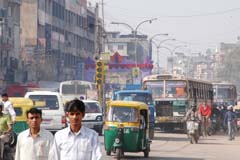InterviewJICA-RI Focus Vol. 36 - Interview with Senior Research Fellow Hiroaki Shiga
2016.11.30
The rise of emerging donors is forming a new order in the international community, and the area of development cooperation is no exception. A research project on "emerging donors" examines this change process from the standpoint of the interaction between such emerging donors as China, India and Brazil, and the traditional international development community. We asked Senior Research Fellow Hiroaki Shiga, who is engaged in this research and recently published Working Paper No. 125 related to India's democratization aid, about this research and its effect on Japanese development aid.
Profile:
Shiga assumed his current post in 2013 after working at the Overseas Economic Cooperation Fund (currently JICA), the Japan Bank for International Cooperation's department for financing for Russia and the Moscow representative office, the International Finance Bureau (currently the International Affairs Department) of the Ministry of Finance.

- Tell us about your background and the objectives of your research.
Actually, since the 1950s, developing countries like China and India have been providing aid to other developing countries while they were major aid recipients. However, since the amount of aid provided by China rapidly increased in the mid-2000s, developed countries have started to pay attention to this so-called emerging donor’s aid. The initial reaction of developed countries to such aid was quite negative and full of skepticism. When developed countries provide aid, they take into account such factors as the state of democracy, human rights and environmental protection in the recipient country. However, the common view among developed countries was that emerging donors, foremost among them China, were giving aid for their own national interest without paying due attention to these factors.
Developed countries regarded the aid by emerging donors as hindering the development of recipient countries, but actually the views of recipient countries receiving aid from emerging donors have almost never been listened to. This research project started from the idea that first you should probably investigate the views of the recipient countries before you discuss the pros and cons of aid by emerging donors. Broadening our focus from China to other countries such as India and Brazil, we focused on clarifying the actual situation while emphasizing the viewpoints of recipient countries.
- What has your research revealed so far?
Developed countries lump together China, India and other "emerging donors," and then criticize them with a focus on China's way of providing aid. However, we learned that the aid of "emerging donors" is actually quite diverse. We tend to introduce a simplistic dichotomy of emerging donor aid as bad and developed country donor aid as good, but we learned that the aid of both developed countries and emerging nations have their own advantages and disadvantages. Recipient countries are watching those features and shrewdly selecting each for different purposes. In other words, the aid of emerging donors is compensating for the deficiencies of that of developed countries.
Taking, for example, the road sector in Cambodia, the Cambodian government has assessed that Japan's aid is high-quality but expensive and taking too much time, while that of China and India is inexpensive and fast. That is to say, the Cambodian government has recognized that while Japan's aid sometimes takes four to five years to begin construction after receiving a request from the recipient country, China responds much more expeditiously. The Cambodian government is much more appreciative of the rapidness of aid in the case of rural roads, even if the quality is a bit poor.
In its aid, China emphasizes that its aid is for "equality and mutual benefit," meaning that the provider and recipient of aid are equal, and they have a win-win relationship. It is a completely different philosophy from Europe and the U.S., which tend to think of aid as a charity. This Chinese aid norm is actually quite similar to the Japanese philosophy of aid. Chinese aid is based on its "Da Jingmao," in which it uses aid as a tool to promote Chinese trade and investment. This too is similar to Japan's "trinity" approach, in which it tried to coordinate its aid, private investment and trade in an effective manner. We extrapolate that such points of similarity are something China learned from its experience receiving aid from Japan, and that is one big finding from this research. Similarly, Thailand, which was a major recipient of Japanese aid, is making use of that experience in providing aid to Myanmar. As you can see, emerging donors are leveraging their past experiences of receiving aid to develop their own aid norms and modality. This is a big difference from developed countries that have never experienced being a recipient country.

A road built by China in the Democratic Republic of the Congo (Photo: JICA/Shinichi Kuno)
- How did you come to research democratization aid by India?
In our research on emerging donors, we found that India is carrying out its own aid for the promotion of democracy in other developing countries. Democratization aid can be broadly divided into two types: supports for democratic transition, in which an authoritarian regime is converted into a democratic one, and supports for democratic consolidation, in which democracy is substantially consolidated and strengthened in a country that has already formally adopted a democratic system. The former is the method that the U.S. has carried out in such countries as Ukraine, Georgia and Iraq, and it emphasizes the importance of direct support for opposition parties, NGOs and media that confront authoritarian rulers. The former stands out more than the latter and Europe and the U.S. tend to value the former more, but India's democratization aid is the latter, aiming to consolidate and strengthen democracy. Since gaining its own independence, India has been leveraging its own experience with constitutional democracy to develop a wide range of activities to support democratization.
One distinguishing feature of India's democratization aid is that it adheres to the principle of non-intervention in the domestic affairs of another nation. I think one reason behind this is that India received large sums of aid from both the U.S. and the Soviet Union during the Cold War and the donor countries meddled in the economic and foreign policies of India. In neighboring countries such as Nepal, Myanmar and Sri Lanka, as well as in African countries, India is engaged in the following types of activities: promoting an environment that allows the socially weak, including women and minorities, to vote; engaging in activities to increase voter participation; teaching techniques to prevent election fraud; and teaching members of parliament how to draft bills. India also dispatches experts to support the drafting of constitutions in many developing countries.

India supports for democratic consolidation (Photo: JICA/Mika Tanimoto)
Interestingly, India never refers to its own aid as "democratization aid." It probably fears its own activities may be seen as the same light as the proselytizing support for democratization by the U.S. Actually, Japan takes a similar approach. JICA also provides aid for the consolidation of democratic systems and practices, using the word "governance aid" instead of "democratization aid." Japan is unique among developed country donors in that it shares with India and China the principles of non-intervention in the domestic affairs of the recipient countries and aid for mutual benefit.
The U.S. and European donors are skeptical about India's approach of supporting democratization to maintain the principle of non-intervention in the domestic affairs of the recipients. They expected that India would join their effort to facilitate democratic transition of authoritarian regimes. However, the issue that many developing countries actually face is democratic consolidation. India, which is still struggling to consolidate its own democracy, is a living example for other developing countries. We found some developing countries, including those in Africa, have positive opinion on the exchange of experiences with India because India shares with them concerns related to contemporary issues. And the reality is that India and other developing countries have formed an active network for the intellectual exchange of members of parliament and Supreme Court judges.
My original specialty was researching ethnic problems in the former Soviet Union. When I was a university student, the Soviet Union collapsed and I saw the world order of bipolar opposition between the U.S. and the Soviet Union crumble. I felt I understood Henry Kissinger's aphorism that you should never say never in the world of international politics. And I was shocked that contrary to the expectation that the end of the Cold War would bring about the dividend of peace, ethnic and religious conflicts broke out all over the world. The starting point of my research was taking an interest in how people can somehow compromise and co-exist in cultural, ethnic and religious diversity. Having researched ethnic problems in the former Soviet Union, India, which is maintaining constitutional democracy after independence despite having numerous problems related to cultural, religious and ethnic diversity, is mysterious and endlessly fascinating to me. I found it meaningful to be able to investigate India's democratization aid recently through research on aid by emerging nations.
- What do you think about the relationship between your research and "quality growth?"
In recent years, there is a growing consensus that growth, as measured by increases in GDP, must also accompany other elements such as resilience, inclusiveness and sustainability— referred to as "quality growth." One reason for the development of this concept is the failure of the structural adjustment policy. Developed country donors and international organizations introduced this policy into developing countries based on neoclassical economics. The policy, however, brought about greater disparities between rich and poor and even frustrated economic growth. The austerity measures and other prescriptions under structural adjustment policy reduced social welfare budgets and brought about social strains. And yet, the governments of developing countries had to accept the policy imposed by the donors.
The rising prominence of emerging donors seems to have ushered in an era of great competition in aid. When developed countries were the dominant providers of aid, recipient countries had very little power to negotiate with donors. But with the emergence of such alternatives as China and India, it has become possible for recipient countries to clearly voice their opinions to developed country donors.
Recipient countries point out one advantage of aid from emerging donors: consistent and stable aid policies. As they say, while developed countries' priority aid areas change almost every 10 years regardless of the opinions of the recipient countries, the aid policies of emerging donors have been stable for many years, making them easier to trust as development partners.
In this context, developed country donors have started to have more respect for the intentions of recipient countries when planning aid policies. And Japan, which is closer to emerging donors with respect to aid policy consistency, has begun to be pressed to speed up and reform its process for providing ODA loans. On the other hand, emerging donors such as China are being forced to pay attention to the governance problems (e.g. corruption) of recipient countries as their engagement with African countries deepens, and they are changing their aid policies. I think the appearance of emerging donors is a great opportunity for every actor to improve the overall quality of its cooperation.

事業事前評価表(地球規模課題対応国際科学技術協力(SATREPS)).国際協力機構 地球環境部 . 防災第一チーム. 1.案件名.国 名: フィリピン共和国.

事業事前評価表(地球規模課題対応国際科学技術協力(SATREPS)).国際協力機構 地球環境部 . 防災第一チーム. 1.案件名.国 名: フィリピン共和国.

事業事前評価表(地球規模課題対応国際科学技術協力(SATREPS)).国際協力機構 地球環境部 . 防災第一チーム. 1.案件名.国 名: フィリピン共和国.

事業事前評価表(地球規模課題対応国際科学技術協力(SATREPS)).国際協力機構 地球環境部 . 防災第一チーム. 1.案件名.国 名: フィリピン共和国.

事業事前評価表(地球規模課題対応国際科学技術協力(SATREPS)).国際協力機構 地球環境部 . 防災第一チーム. 1.案件名.国 名: フィリピン共和国.
scroll